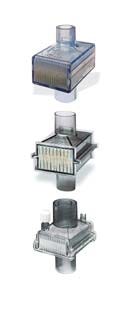Filters Meet the Changing Demands of the Industry
September 12, 2003
Originally Published MPMNSeptember 2003
PRODUCT UPDATE
Filters Meet the Changing Demands of the Industry
When it comes to the filters used in the medical device industry, size and material matter. The dimensions of a pore could literally mean life or death, depending on the purpose of the filter. Whether the goalis combatting an outbreak of a contagious disease or just perfecting an existing line of filters, manufacturers continually seek new solutions. Following are a few examples of recent filter developments that may be of interest to MPMN readers.
|
Pall Medical's breathing filters reduce the risk of contamination in ventilator circuits. |
Breathing filters prevent viral and bacterial contamination
When infectious diseases threaten hospitals, the use of high-efficiency filters such as Pall Medical's BB25A, Ultipor 100, and BB50T may prevent the transmission of contaminants to patients and healthcare workers. The three breathing-system filters have been validated with a microbial removal rating of 99.999% to block liquids such as tracheal discharge and saliva when faced with a monodispersed challenge of a host of pathogens. The products are used with ventilators, anesthesia machines, and manual-resuscitation bags, preventing contaminated secretions from passing into the ventilator circuit.
"Breathing-circuit filters that combine a reliable hydrophobic barrier and high levels of viral and bacterial retention offer the best option to protect therapeutic equipment and minimize exposure of patients and healthcare workers to infectious respiratory secretions," says Judy Angelbeck, senior vice president of Pall Medical.
With an internal volume of 85 ml, the Ultipor 100 is a 15-mm-diam flexible tube with the options of a protective cap to replace conventional catheter mounts, a CO2-monitoring port with a luer lock, or a tethered cap. Constructed with pleated hydrophobic resin and bonded inorganic chemical fibers, the filter is resistant to water and nebulized medication droplets.
The BB25A is a small-volume anesthesia filter, made of materials free of natural rubber latex. With a volume of 35 ml, the product offers a CO2-monitoring port for filtration protection and retains heat and humidity for anesthesia patients. The BB50T removes ribavirin, pentadimine, histamine, and methacholine exhaust to protect the hospital staff and the environment from bacteria.
PEEK polymer fits filtration and separation applications
|
PEEK fabrics from Sefar America Inc. offer small pore sizes to resist a wide range of inorganic and organic chemicals. |
A PEEK monofilament fabric introduced by Sefar America Inc. is suitable for drying applications where temperature resistance, light weight, flexibility, and performance in chemically corrosive environments are required. With pore sizes starting at 10 µm, the fabric's thickness is as low as 60 µm with basis weights of 0.8 oz/sq yd and up. The product's fibers are as small as 30 µm in diameter, with up to 600 of the threads woven into each inch of the material.
The PEEK polymer, available for filtration and separation applications, "can be at 450° to 500°F, and is resistant to a wide range of inorganic and organic chemicals," according to Rick Gaiser, Sefar America's manager of market development. "This fabric's high mechanical strength makes it a very durable fiber for wear resistance and dimensional stability at high temperatures."
Gaiser explains that PEEK fabrics have a 200°F temperature advantage over nylon 6/6, and higher elongation compared with polyphenylene sulfide fiber, enabling better impact recovery. The material is available as roll goods for customer fabrication or as fabricated components.
Diagnostic membranes offer a variety of flow rates for assays
|
Backed nitrocellulose membranes by Millipore Corp. enable flexibility in the optimization of immunoassay selectivity and sensitivity. |
A complete line of nitrocellulose membranes is offered for lateral-flow diagnostic assays. The membranes feature a smooth surface quality to enhance the consistency of reagent striping. The backed nitrocellulose Hi-Flow Plus membranes by Millipore Corp. offer capillary flow rates ranging from 65 to 240 seconds/4 cm to allow flexibility in the optimization of immunoassay selectivity and sensitivity. To avoid interfering with assay performance, the product is directly cast onto a clear polyester backing with a thickness of either 2 or 4 mil, reducing any occurrences of an adhesive migrating into the membrane substrate in a finished test strip.
Hi-Flow Plus 120 has a nominal flow time of 120 seconds across 4 cm of membrane, while Hi-Flow Plus 180's nominal flow time measures 180 seconds across 4 cm. Both comply with an average flow time variance of 11% and a thickness variance of 6%. Three other products in the Hi-Flow Plus line feature lateral flow times of 75, 90, and 135 seconds across 4 cm of membrane, respectively. Hi-Flow Plus 65 is suitable for tests where speed is critical, the analyte is plentiful, and sensitivity is not a concern. On the other hand, Hi-Flow Plus 240 is appropriate for slower tests with limited analyte and necessity for high sensitivity.
Before shipment, each 100-m master roll is sampled in six areas across the head and tail end, inspected for surface quality, and tested for capillary flow rate and thickness. The tests are done on the actual roll sent to the customer, rather than on edges trimmed off during casting.
Copyright ©2003 Medical Product Manufacturing News
You May Also Like



.png?width=300&auto=webp&quality=80&disable=upscale)

